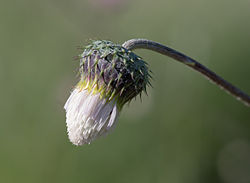| Tyrimnus | |
|---|---|
 | |
 | |
| Scientific classification | |
| Kingdom: | Plantae |
| Clade: | Tracheophytes |
| Clade: | Angiosperms |
| Clade: | Eudicots |
| Clade: | Asterids |
| Order: | Asterales |
| Family: | Asteraceae |
| Subfamily: | Carduoideae |
| Tribe: | Cardueae |
| Subtribe: | Carduinae |
| Genus: | Tyrimnus (Cass.) Cass. [1] |
| Species: | T. leucographus |
| Binomial name | |
| Tyrimnus leucographus | |
| Synonyms [2] | |
| |
Tyrimnus is a genus of Mediterranean plants in the tribe Cardueae within the family Asteraceae. [3] [4] The only known species is Tyrimnus leucographus, native to the Mediterranean region of southern Europe, North Africa, and the Middle East. [3] [5]